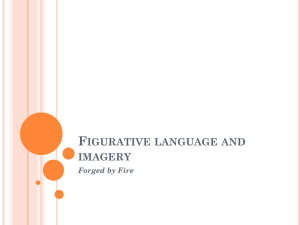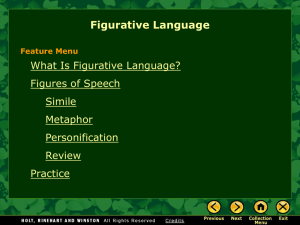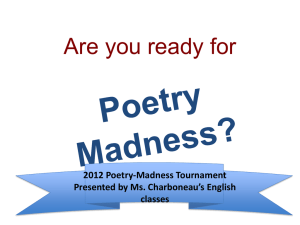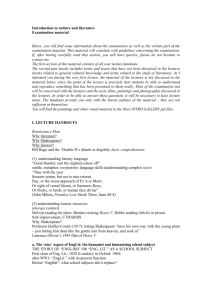LiteratureFigurative language
advertisement
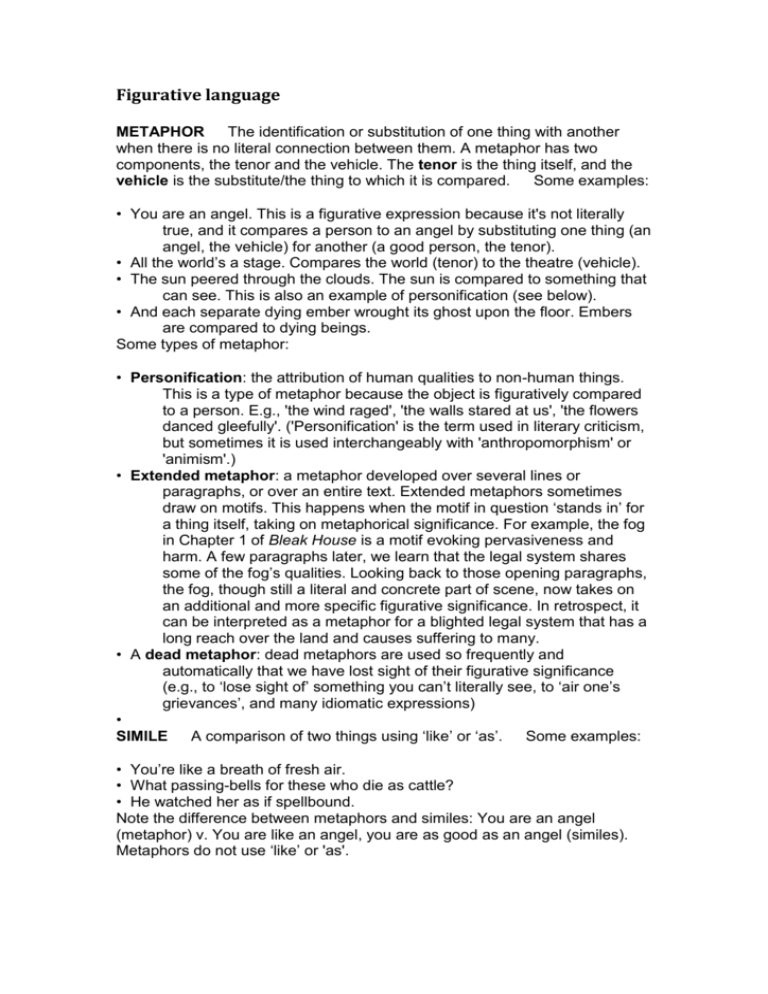
Figurative language
METAPHOR
The identification or substitution of one thing with another
when there is no literal connection between them. A metaphor has two
components, the tenor and the vehicle. The tenor is the thing itself, and the
vehicle is the substitute/the thing to which it is compared.
Some examples:
• You are an angel. This is a figurative expression because it's not literally
true, and it compares a person to an angel by substituting one thing (an
angel, the vehicle) for another (a good person, the tenor).
• All the world’s a stage. Compares the world (tenor) to the theatre (vehicle).
• The sun peered through the clouds. The sun is compared to something that
can see. This is also an example of personification (see below).
• And each separate dying ember wrought its ghost upon the floor. Embers
are compared to dying beings.
Some types of metaphor:
• Personification: the attribution of human qualities to non-human things.
This is a type of metaphor because the object is figuratively compared
to a person. E.g., 'the wind raged', 'the walls stared at us', 'the flowers
danced gleefully'. ('Personification' is the term used in literary criticism,
but sometimes it is used interchangeably with 'anthropomorphism' or
'animism'.)
• Extended metaphor: a metaphor developed over several lines or
paragraphs, or over an entire text. Extended metaphors sometimes
draw on motifs. This happens when the motif in question ‘stands in’ for
a thing itself, taking on metaphorical significance. For example, the fog
in Chapter 1 of Bleak House is a motif evoking pervasiveness and
harm. A few paragraphs later, we learn that the legal system shares
some of the fog’s qualities. Looking back to those opening paragraphs,
the fog, though still a literal and concrete part of scene, now takes on
an additional and more specific figurative significance. In retrospect, it
can be interpreted as a metaphor for a blighted legal system that has a
long reach over the land and causes suffering to many.
• A dead metaphor: dead metaphors are used so frequently and
automatically that we have lost sight of their figurative significance
(e.g., to ‘lose sight of’ something you can’t literally see, to ‘air one’s
grievances’, and many idiomatic expressions)
•
SIMILE
A comparison of two things using ‘like’ or ‘as’.
Some examples:
• You’re like a breath of fresh air.
• What passing-bells for these who die as cattle?
• He watched her as if spellbound.
Note the difference between metaphors and similes: You are an angel
(metaphor) v. You are like an angel, you are as good as an angel (similes).
Metaphors do not use ‘like’ or 'as'.
Motifs, Images and Theme
An image evokes a sense response. That response is often visual, but an
image can actually appeal to our sense of smell, taste, touch, or sound, too. If
the same types of images are repeated across a text, they might form a motif.
Other recurring details, such as repeated phrases or character types, can be
motifs of a text or an entire genre, too. I think it helps to think of a motif as
a recurring, often concrete representation of an idea, a bit like a refrain in a
song. (e.g. colour, weather, can be motifs).
Theme
An argument or dominant idea or question expressed by a work of art, overtly
or not, or an issue the work raises. An example would be a novel about the
life and death of a boy in London that had a theme of the social injustice of the
Victorian period. Often, the theme is not something tangible or touched on
directly. It's not always something we can hold or see, but something we can
conceptualize.
Semantic field
A set of words relating to a particular area of meaning. Examples: ‘tractor’,
‘cow’, ‘barn’,‘harvester’, ‘sheep’, ‘shearing’, ‘crop’ and ‘hay’ all belong to the
semantic field of agriculture; ‘welding’, ‘machine’ ‘engine’ ‘steel’ and ‘furnace’
all belong to the semantic field of manufacturing or industry. Words in different
contexts can of course belong to different semantic fields.
Dialogue
The representation of speech.
Discourse
This term has a variety of meanings but we shall be using it to mean language
being used, not the abstract concept of the system of language.
Focaliser
The character through whose eyes we see the events of a narrative.
Internal monologue
Internal because inside the mind of a character, monologue because (usually)
there is only one voice in there. The representation of thoughts.
Narrative
The relation or other representation (not necessarily verbal or written) of a
series of events, whether factual or fictitious.
Narrative voice
The ‘voice’ relating the events in a text. A useful term because it prevents our
confusing this fictional voice with that of the real historical or living author.
Omniscient narrator
One who can see everything going on in a narrative and can dip in and out of
different characters’ thoughts and perspectives at will.
Protagonists
The ‘actors’ or characters to whom the events of the narrative happen. The
central protagonist/s is/are the main characters at the centre of the action or
narrator’s interest.
Perspective
The origin point ( for example, a character) from which events are observed
and/or narrated. A limited perspective narrative is one in which the narrator
tends to see things from the point of view of one character, usually the central
protagonist.
Voice
The style of the words of the narrative, which may suggest a ‘real’ narrator
behind them.
Characterisation
The method of encouraging readers to ascribe to characters personality traits
and attributes.
Pathetic fallacy
A representation of the idea that human mood or physical state can be
affected by and can affect the weather or the elements. An example would be
a heroine rejected by a lover and in a state of dejection finding that the
weather had become overcast and rainy.
Symbol
Sometimes used interchangeably with metaphor, but more specifically a
metaphor which has more than one referent and which will have specific
significance within a culture.
Examples would include the moon, swans and owls, all of which can
symbolise a number of things (the moon can stand for changeability, mystery,
magic, the goddess, women…) and whose significance is common to most
literate people in Western culture.
Irony
In literature something said by a narrative voice or character that seems to
mean one thing when interpreted at face value, but which will be interpreted
as having a different meaning, possibly the opposite of its apparent meaning.
At its most simple, this could be a soldier watching another run away from a
battle and saying ‘He’s a brave man.’ A more complex form can be found in
Jane Austen’s novels, where readers often follow events through the eyes of
the central protagonist (the heroine) but are encouraged to judge them
through the narrative voice, whose perspective may be different.
Source: Critical reading on-lineforum


